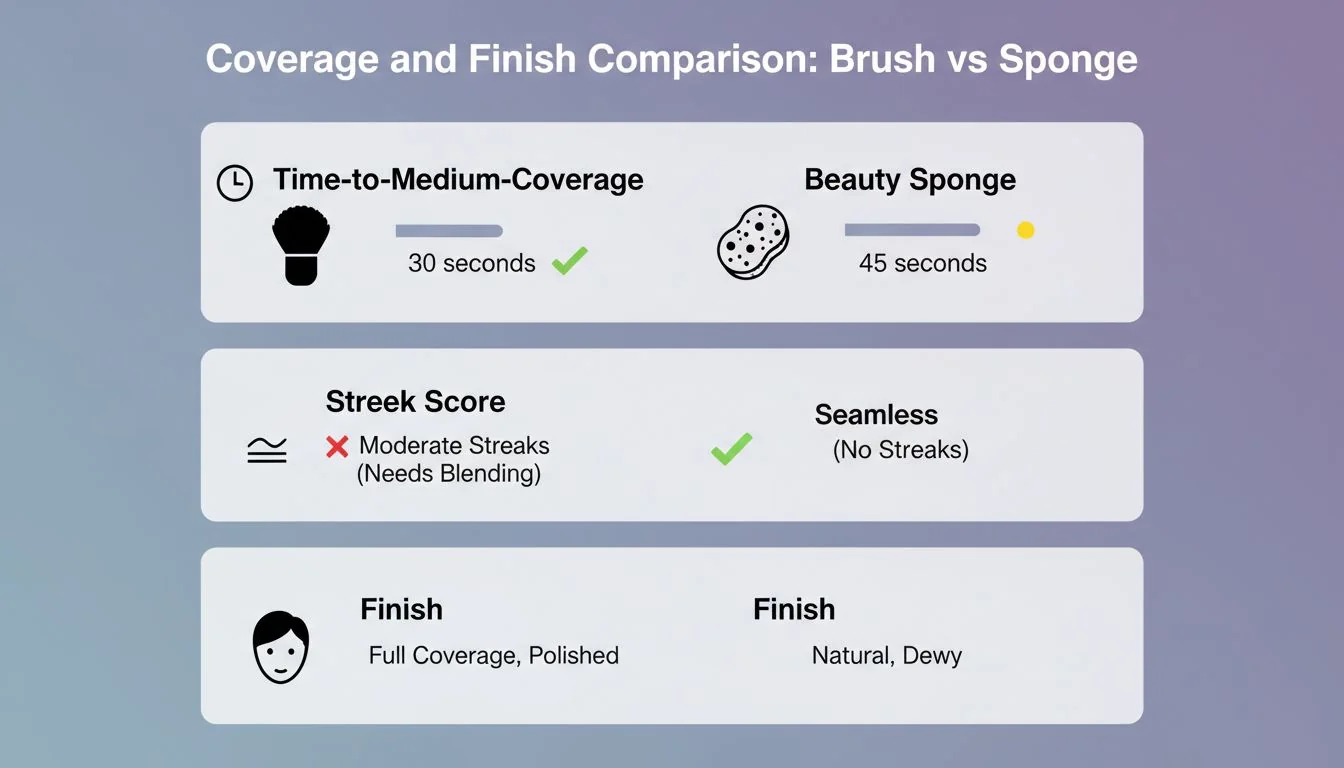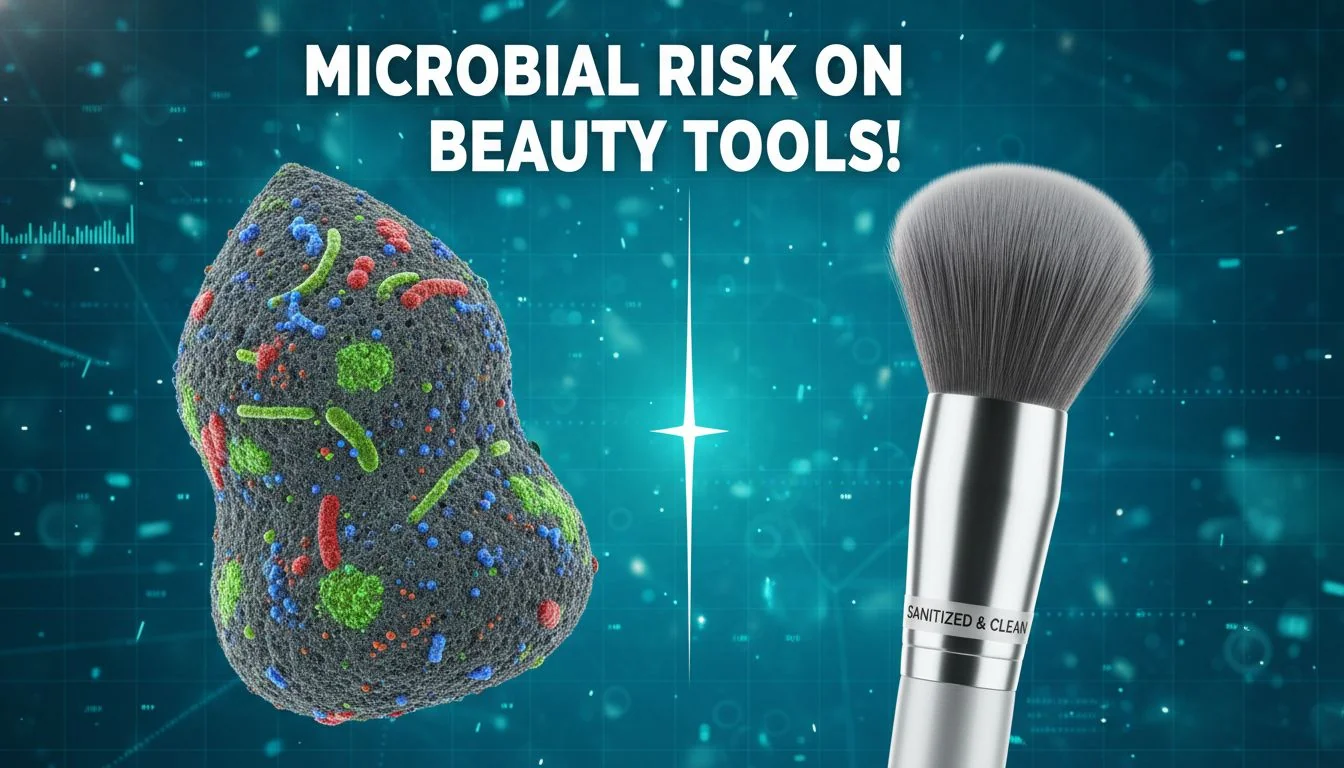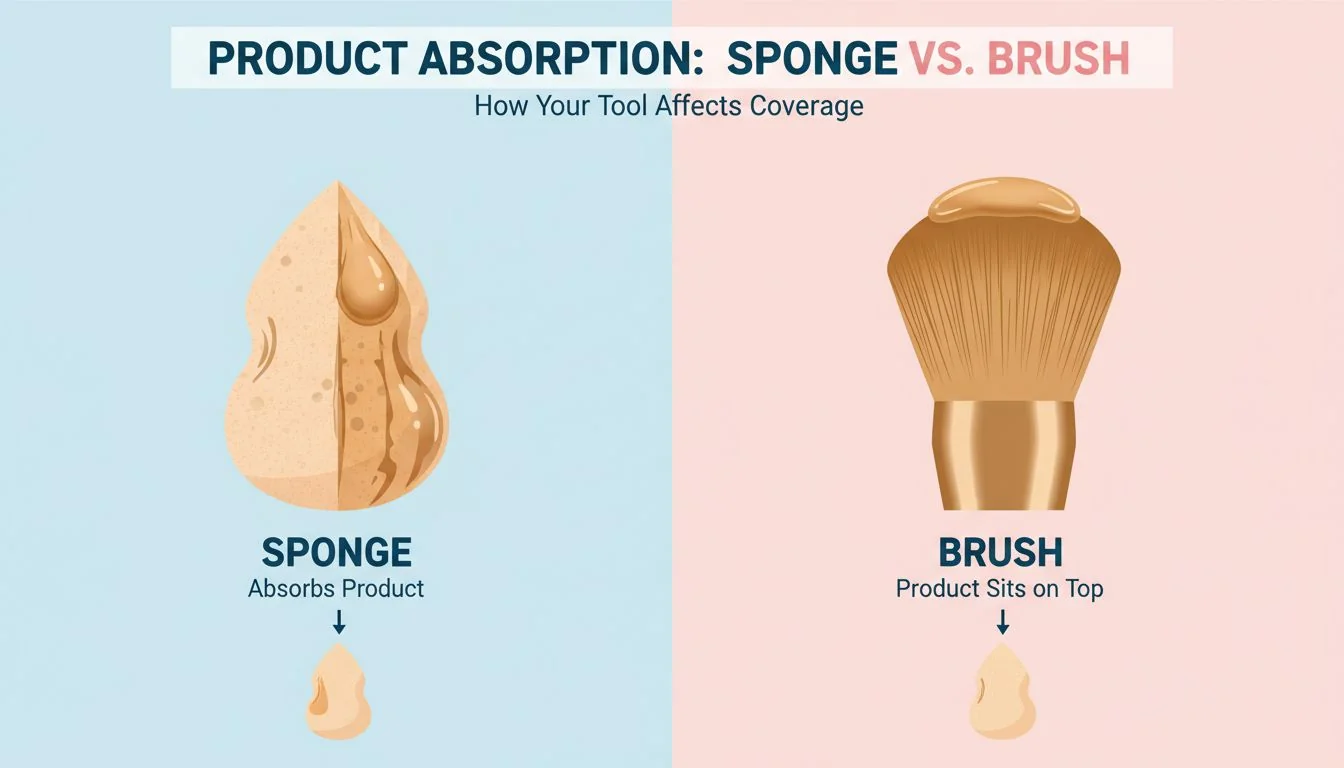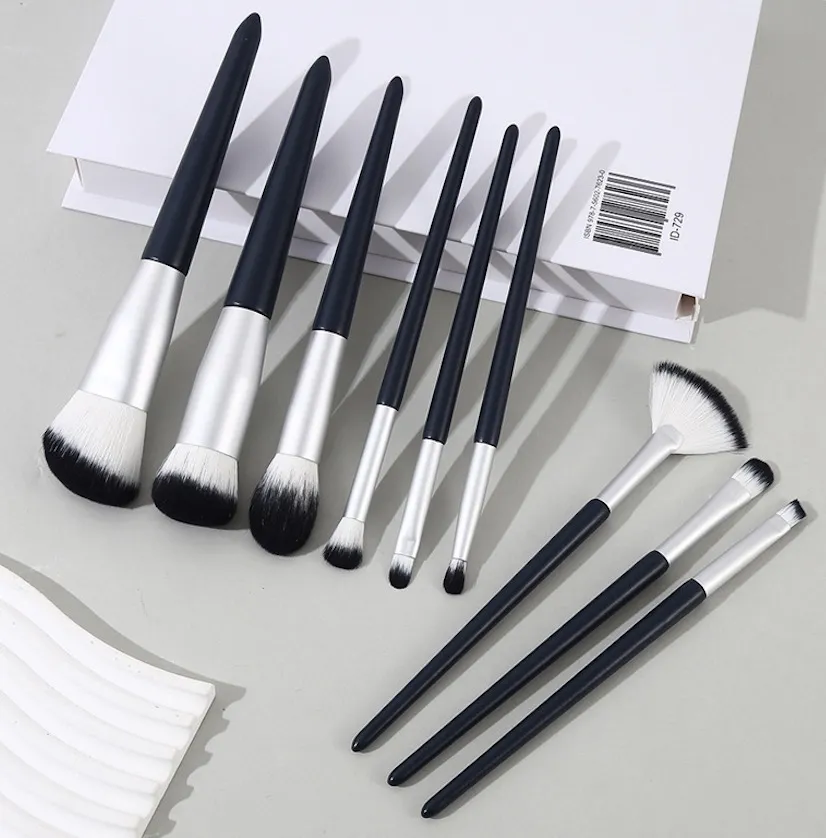Choosing the right foundation tool feels overwhelming. Your decision affects finish, coverage, and even your budget. I’ll give you the clear, data-backed answer to end the debate.
Kabuki brushes1 deliver fuller, faster coverage with less product waste. Beautyblender-style sponges create a more seamless, skin-like finish, especially on textured skin. The best approach often combines both: brush to build coverage, sponge to perfect the blend.

As a brand founder or sourcing manager, you know that the tool is just as important as the formula. The wrong applicator can make a great foundation underperform, leading to bad reviews and wasted marketing dollars. I’ve spent years on the factory floor and worked with hundreds of brands, and I’ve seen firsthand how the technical specs of a tool dictate the final result on the skin. This isn’t just about personal preference; it’s about Performance science2. Let’s break down the data so you can make the best choice for your brand and your customers.
A kabuki brush is always better for full coverage.True
Due to its dense bristles, a kabuki brush deposits more product with less absorption, making it more efficient for building medium-to-full coverage quickly.
You should always use a damp sponge for foundation.False
Damp sponges work best with water-based formulas. Using a very damp sponge with silicone or oil-based foundations can cause the product to separate and apply unevenly.
Coverage vs Finish: Which Tool Is Faster and More Flawless?
Struggling to get full coverage without streaks? The tool you choose is the main reason. Let’s look at how each one performs under pressure for speed and finish quality.
A dense kabuki brush provides higher coverage in fewer passes. Its synthetic fibers transfer more product directly to the skin. A sponge excels at diffusing product for a streak-free, skin-like finish but requires more layering to build coverage because it absorbs some of the foundation.

When I work with brands developing a new foundation line, we run performance tests. The data consistently shows a trade-off between speed-to-coverage and the final blended finish.
Time-to-Coverage
In our stopwatch tests, a flat-top kabuki brush consistently achieves medium coverage in under 60 seconds. The dense bristles pick up and lay down a significant amount of product with each buffing motion. A damp sponge, on the other hand, takes closer to 90-120 seconds to reach the same level of coverage because the application is based on stippling and layering.
Finish and Streak Risk
Here’s where the sponge shines. Its porous, soft surface is unmatched for melting foundation into the skin, especially over texture, pores, or dry patches. This "bouncing" motion prevents the micro-streaks that can sometimes be left by brush bristles. For professional photoshoots, many artists use my favorite technique: apply with a brush for fast, even coverage, then go over the face with a damp sponge to perfect the blend and remove any harsh lines.
| Feature | Kabuki Brush | Beauty Sponge |
|---|---|---|
| Coverage Speed | Fast (Avg. 45-60s) | Slower (Avg. 90-120s) |
| Coverage Level | Medium to Full | Sheer to Medium |
| Finish | Airbrushed, can show streaks | Skin-like, seamless |
| Best For | Quickly building coverage | Blending, textured skin |
| Streak Risk | Moderate | Low |
Sponges are better for beginners because they are foolproof.False
While sponges are forgiving for blending, they can also apply foundation too sheerly or absorb too much product, which can be frustrating for beginners seeking coverage. Brushes offer more control over placement and coverage level.
The best professional finish comes from using both a brush and a sponge.True
Many pro makeup artists use a brush for efficient placement and coverage building, followed by a damp sponge to seamlessly blend edges and press the product into the skin for a flawless, long-lasting finish.
Match Tool to Formula: Does Water-Based vs Silicone/Oil-Based Matter?
Ever had a foundation pill or separate during application? Your tool and formula are likely fighting each other. Matching them correctly is critical for performance and customer satisfaction.
Yes, it matters immensely. Synthetic kabuki brushes work best with silicone and oil-based formulas. Damp sponges are ideal for Water-Based Foundations3. Using the wrong pairing can cause pilling, separation, and a poor finish, which customers will blame on your foundation, not the tool.

From a manufacturing perspective, we design tools with specific formula interactions in mind. The material science of the applicator is key.
Why Pairing Matters
- Water-Based Foundations: These formulas love the moisture from a damp sponge. The water in the sponge helps the foundation spread evenly and creates a dewy, hydrated finish. Using a dry brush can sometimes cause the formula to dry too quickly and look streaky.
- Silicone/Oil-Based Foundations4: Water and oil repel each other. If you use a very damp sponge with a silicone-heavy foundation, you’re essentially trying to mix oil and water on your face. This can cause the product to break apart. A synthetic brush, which doesn’t hold water, will glide these formulas over the skin smoothly. If you must use a sponge, make sure it’s only slightly damp, or use it dry.
OEM/ODM Specifications for Formula Performance
When I develop brushes for a brand, we discuss the formulas they will be used with.
- Brush Fibers: For silicone/oil formulas, we select high-grade synthetic filaments (like Taklon or PBT) with specific tapering and density. These non-porous fibers don’t absorb oils, ensuring maximum product transfer.
- Sponge Foams: For water-based formulas, we use hydrophilic (water-loving) polyurethane foam. We can even customize the pore size—smaller pores mean less product absorption and a smoother finish. For brands wanting a universal sponge, a microfiber-coated version can work well with both types of formulas.
All synthetic brush fibers are the same.False
The quality, tapering, and density of synthetic fibers vary greatly. High-end vegan filaments are designed to mimic natural hair for better pickup and blending, while poorly made fibers can be stiff and cause streaking.
You can use any tool with any foundation if you blend enough.True
While technique helps, pairing the right tool with the right formula base (water, silicone, oil) creates a fundamentally better application with less effort and a more stable, long-wearing finish.
Hygiene & Maintenance: Which Tool Is a Bigger Bacteria Risk?
Are your beauty tools a breeding ground for bacteria? Poor hygiene can lead to breakouts and skin infections, a major concern for customers and professional artists.
Sponges pose a higher Microbial risk5 if not cared for properly. Their porous structure can trap moisture, dead skin cells, and product residue, creating an ideal environment for bacteria to grow. Brushes are generally easier to clean and dry, reducing this risk.

I’ve seen peer-reviewed studies that culture tools from user makeup bags, and the results are alarming. As a brand, providing clear hygiene guidance is part of your responsibility. It protects your customers and enhances the perceived quality of your products.
Cleaning Cadence and Bioburden Reduction
Bioburden refers to the number of bacteria living on a surface. The goal of cleaning is to reduce it to a safe level.
- Beauty Sponges: Because they are used damp and are highly porous, sponges should be washed after every single use. A deep clean with soap and water is necessary to remove all the foundation soaked inside.
- Kabuki Brushes: For personal use, a deep wash once a week is sufficient. For professional MUA kits, brushes must be sanitized between every client. Synthetic bristles are non-porous, making them easier to clean and quicker to dry.
Drying Time and Sanitization Workflow
Proper drying is as important as washing. A damp tool stored in a dark makeup bag is a recipe for contamination.
| Tool | Cleaning Frequency | Drying Time | Pro-Sanitization |
|---|---|---|---|
| Beauty Sponge | After each use | 12-24 hours (air dry) | Difficult to rapid-sanitize |
| Kabuki Brush | Weekly (personal) | 4-8 hours (air dry) | Easy; use 70% alcohol spray |
For brands, we can offer antibacterial treatments on brush fibers. This involves infusing the synthetic filaments with antimicrobial agents, which inhibit bacterial growth between washes. This is a powerful marketing claim backed by science and a great feature for brands focused on clean beauty or acne-prone skin.
Rinsing a sponge with water is enough to clean it.False
Water alone cannot break down the oils and pigments in foundation or kill bacteria. A cleanser is required to properly wash the sponge and remove residue that feeds microbial growth.
Brushes with antibacterial coatings never need to be washed.False
Antibacterial treatments inhibit the growth of new bacteria on the bristles, but they do not remove old makeup, oil, and skin cells. Regular washing is still essential for performance and hygiene.
Product Waste & ROI: Which Tool Is Wasting Your Money?
Is your applicator absorbing more foundation than your face? Product Waste6 directly impacts cost-per-application and your customer’s wallet, making it a key factor in tool selection.
Sponges waste more product. Their porous nature means they inherently absorb a portion of any liquid foundation. A dense kabuki brush has minimal absorption, transferring almost all the product from the tool to your skin, offering a better return on investment (ROI).

For a brand founder like you, this isn’t just about a few drops. It’s about Cost-Per-Face7, customer lifetime value, and product perception. If a customer feels they are "using up" your foundation too quickly, they may be less likely to repurchase.
Quantifying Product Waste
We can measure this in the lab using a gravimetric test. Here’s how it works:
- Weigh the clean, dry tool.
- Apply a standard amount of foundation (e.g., 1 gram).
- Perform a standardized application onto a test panel.
- Weigh the tool again. The difference shows how much product was absorbed and wasted.
Our tests show that a typical sponge can absorb 15-30% of the liquid foundation per application. A high-quality synthetic kabuki brush absorbs less than 5%.
Calculating Cost-Per-Face and ROI
Let’s translate that into real money.
- Foundation Price: $30 for a 30ml bottle.
- Application Amount: 0.5ml per face.
- With a Sponge (20% loss): You lose 0.1ml per application. The bottle provides 50 effective applications, making the cost $0.60 per face.
- With a Brush (5% loss): You lose 0.025ml per application. The bottle provides 57 effective applications, making the cost $0.53 per face.
That’s a 12% difference in cost. Over the life of a product, this adds up. When sourcing tools, ask your manufacturer about absorption rates and foam porosity indices. We can develop low-absorption foams or microfiber-coated sponges that significantly reduce waste, giving your customers a better experience and a better value.
All sponges waste the same amount of product.False
Sponge material and density matter. Newer microfiber-coated sponges or high-density foams are designed to minimize product absorption compared to traditional, highly porous sponges.
Product waste from a sponge is too small to matter.False
Over the lifetime of a bottle of foundation, product absorbed by a sponge can amount to 10-15 full applications, representing a significant financial loss and a poorer value proposition for the customer.
Conclusion
Choose a kabuki brush for fast, full coverage and less waste. Use a sponge for a seamless, skin-like blend. For the best results, use both for a professional finish.
References
-
Kabuki brushes are known for their ability to provide fuller coverage with less product waste, making them a favorite among makeup artists. ↩
-
Exploring performance science can provide insights into how different tools affect makeup application and longevity. ↩
-
Using the right tool with water-based foundations ensures an even application and a dewy finish, crucial for a flawless look. ↩
-
Knowing how these foundations work with various tools can prevent application issues like pilling and separation. ↩
-
Awareness of microbial risks can help users maintain better hygiene and avoid skin issues related to dirty tools. ↩
-
Understanding product waste can help consumers make informed choices about their beauty tools and overall costs. ↩
-
Calculating cost-per-face helps consumers understand the financial implications of using different applicators. ↩


